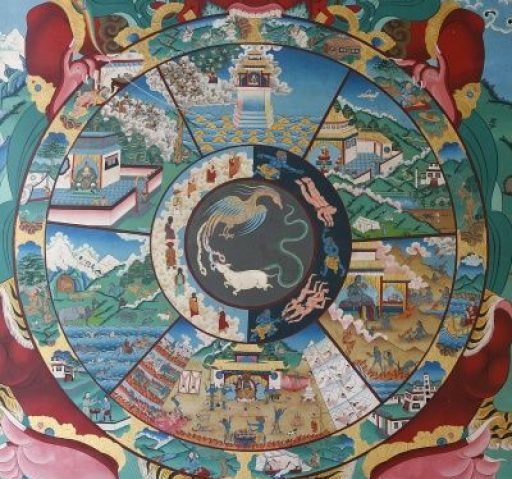Overcoming the Cries from Asian Demonology:
Cinemantic Cultural Crossings
Revised Jan 24, 2023
| All is burning. . . The ear is burning, sounds are burning. . . The nose is burning, odors are burning. . . The tongue is burning, flavors are burning. . . The body is burning, tangibles are burning. . . The mind is burning, ideas are burning . . . — The Fire Sermon The Adittapariyaya Sutra | |
According to the Lotus Sutra (around 2nd BCE), a Buddhist scripture which became popular in the Chinese or Mahayana tradition, a family resides within a house on fire. Within this burning edifice, the children don’t seem to notice even when the father warns them to leave.
We are trapped in the psychic lies of Demonology. Instead, we should cultivate the positivity of peace as the true path of wisdom. Rest in Peace!
Ironically, the fiends, devils, and monsters are more enlightened than their humans counterparts, for they are responsive to the warnings by the father and to the pain of their dead skins being roasted. “All of the goblins and ghosts and beasts howled in fear, not knowing how to escape the burning house” (64 Watson). We don’t listen.

Herein lies the meaning of the parable: humans should know better and should respect the silent screams of demons. The house symbolized more, for it represents their bodies or their realities.
Some are bewitched and bewildered under these imagined tales of horror or these strange narratives of terror. We forgot to decode the empty sounds or the silent howls of horror that Asian audiences expected. The real battle of life is about being awakened to the inner fight, best embodied by the demons we bear within us.
Instead, we also possess the cure to these strange curses. He can arise healthier and stronger if we chose!
Instead, we are all trapped in the hynogogic state of delusion with the multitude of zombies entering our nightmares, paralleling the multitude of real monsters surrounding us, sucking our economies, minds, friends, and souls dry.
Ultimately, horror is neither a fiction nor a genre; instead, it is a metaphor for the chaotic mixed vestiges of life, being neither about good nor evil, nor about death and rebirth. Hence, horror returns us to our true/false sense of realities merging and incorporating the delusion that inundate us. “In our memories, the reality we believe we’ve experience is inevitably mixed with illusion” (Oshii 7). We can mix the positivity of peace if we choose.
What can we say is real, and what can we say is unreal or undead? Stupefied, we stay submerged, immersed, and trapped within a fiery, smoke-filled darkness. We remain hungry ghosts incarcerated within the burning house of horror, waiting for nirvana. [1]
Instead, we can free ourselves from our self made prison.
[1] To reiterate, nirvana literally means extinguishing the flame.
–Doc Nirvana
AKA Dr. Wayne Stein
Portions of this came from a paper entitled “The Blood of Hybridity in Postmodern Cinematic Asian Vampires” which was presented at the Popular Culture Conference in Boston, Massachusetts on April 4, 2007.
These notes are being revised, edited, and published as a chapter in a future anthology of Dracula essays.
Stein, Wayne. “Enter the Dracula: Silent Screams.” from John Browning, and Caroline Joan “Kay” S. Picart. Eds. Draculas, Vampires, and Other Undead Forms: Essays on Gender, Race and Culture. New York: Scarecrow Press, 2009. 235-259.
Works Cited
Oshii, Mamoru. Blood: The Last Vampire, Night of the Beasts. Trans. Camellia Nieh. Milwaukee: D H Press, 2005.
Watson, Burton. Lotus Sutra. New York: Columbia University Press, 1993.
